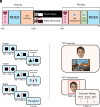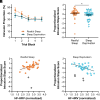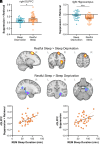Memory control deficits in the sleep-deprived human brain
- PMID: 39739795
- PMCID: PMC11725914
- DOI: 10.1073/pnas.2400743122
Memory control deficits in the sleep-deprived human brain
Abstract
Sleep disturbances are associated with intrusive memories, but the neurocognitive mechanisms underpinning this relationship are poorly understood. Here, we show that sleep deprivation disrupts prefrontal inhibition of memory retrieval, and that the overnight restoration of this inhibitory mechanism is associated with time spent in rapid eye movement (REM) sleep. The functional impairments arising from sleep deprivation are linked to a behavioral deficit in the ability to downregulate unwanted memories, and coincide with a deterioration of deliberate patterns of self-generated thought. We conclude that sleep deprivation gives rise to intrusive memories via the disruption of neural circuits governing mnemonic inhibitory control, which may rely on REM sleep.
Keywords: default mode network; heart rate variability; inhibitory control; memory suppression; sleep deprivation.
Conflict of interest statement
Competing interests statement:The authors declare no competing interest.
Figures




Similar articles
-
Consolidation of strictly episodic memories mainly requires rapid eye movement sleep.Sleep. 2004 May 1;27(3):395-401. doi: 10.1093/sleep/27.3.395. Sleep. 2004. PMID: 15164890
-
REM sleep deprivation inhibits LTP in vivo in area CA1 of rat hippocampus.Neurosci Lett. 2005 Nov 18;388(3):163-7. doi: 10.1016/j.neulet.2005.06.057. Neurosci Lett. 2005. PMID: 16039776
-
Possible mechanism involved in sleep deprivation-induced memory dysfunction.Methods Find Exp Clin Pharmacol. 2008 Sep;30(7):529-35. doi: 10.1358/mf.2008.30.7.1186074. Methods Find Exp Clin Pharmacol. 2008. PMID: 18985181
-
The REM sleep-memory consolidation hypothesis.Science. 2001 Nov 2;294(5544):1058-63. doi: 10.1126/science.1063049. Science. 2001. PMID: 11691984 Free PMC article. Review.
-
The case against memory consolidation in REM sleep.Behav Brain Sci. 2000 Dec;23(6):867-76; discussion 904-1121. doi: 10.1017/s0140525x00004003. Behav Brain Sci. 2000. PMID: 11515146 Review.
Cited by
-
Brain mechanisms underlying the inhibitory control of thought.Nat Rev Neurosci. 2025 Jul;26(7):415-437. doi: 10.1038/s41583-025-00929-y. Epub 2025 May 16. Nat Rev Neurosci. 2025. PMID: 40379896 Review.
References
-
- Benoit R. G., Hulbert J. C., Huddleston E., Anderson M. C., Adaptive top-down suppression of hippocampal activity and the purging of intrusive memories from consciousness. J. Cogn. Neurosci. 27, 96–111 (2015). - PubMed
MeSH terms
Grants and funding
LinkOut - more resources
Full Text Sources

